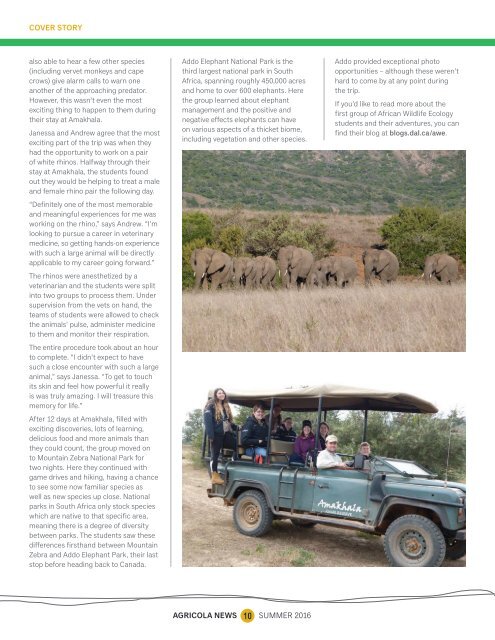BALANCING AGGIES IN
saFU303xLlW
saFU303xLlW
You also want an ePaper? Increase the reach of your titles
YUMPU automatically turns print PDFs into web optimized ePapers that Google loves.
COVER STORY<br />
also able to hear a few other species<br />
(including vervet monkeys and cape<br />
crows) give alarm calls to warn one<br />
another of the approaching predator.<br />
However, this wasn’t even the most<br />
exciting thing to happen to them during<br />
their stay at Amakhala.<br />
Janessa and Andrew agree that the most<br />
exciting part of the trip was when they<br />
had the opportunity to work on a pair<br />
of white rhinos. Halfway through their<br />
stay at Amakhala, the students found<br />
out they would be helping to treat a male<br />
and female rhino pair the following day.<br />
“Definitely one of the most memorable<br />
and meaningful experiences for me was<br />
working on the rhino,” says Andrew. “I’m<br />
looking to pursue a career in veterinary<br />
medicine, so getting hands-on experience<br />
with such a large animal will be directly<br />
applicable to my career going forward.”<br />
The rhinos were anesthetized by a<br />
veterinarian and the students were split<br />
into two groups to process them. Under<br />
supervision from the vets on hand, the<br />
teams of students were allowed to check<br />
the animals’ pulse, administer medicine<br />
to them and monitor their respiration.<br />
The entire procedure took about an hour<br />
to complete. “I didn’t expect to have<br />
such a close encounter with such a large<br />
animal,” says Janessa. “To get to touch<br />
its skin and feel how powerful it really<br />
is was truly amazing. I will treasure this<br />
memory for life.”<br />
After 12 days at Amakhala, filled with<br />
exciting discoveries, lots of learning,<br />
delicious food and more animals than<br />
they could count, the group moved on<br />
to Mountain Zebra National Park for<br />
two nights. Here they continued with<br />
game drives and hiking, having a chance<br />
to see some now familiar species as<br />
well as new species up close. National<br />
parks in South Africa only stock species<br />
which are native to that specific area,<br />
meaning there is a degree of diversity<br />
between parks. The students saw these<br />
differences firsthand between Mountain<br />
Zebra and Addo Elephant Park, their last<br />
stop before heading back to Canada.<br />
Addo Elephant National Park is the<br />
third largest national park in South<br />
Africa, spanning roughly 450,000 acres<br />
and home to over 600 elephants. Here<br />
the group learned about elephant<br />
management and the positive and<br />
negative effects elephants can have<br />
on various aspects of a thicket biome,<br />
including vegetation and other species.<br />
Addo provided exceptional photo<br />
opportunities – although these weren’t<br />
hard to come by at any point during<br />
the trip.<br />
If you’d like to read more about the<br />
first group of African Wildlife Ecology<br />
students and their adventures, you can<br />
find their blog at blogs.dal.ca/awe.<br />
AGRICOLA NEWS 10 SUMMER 2016






